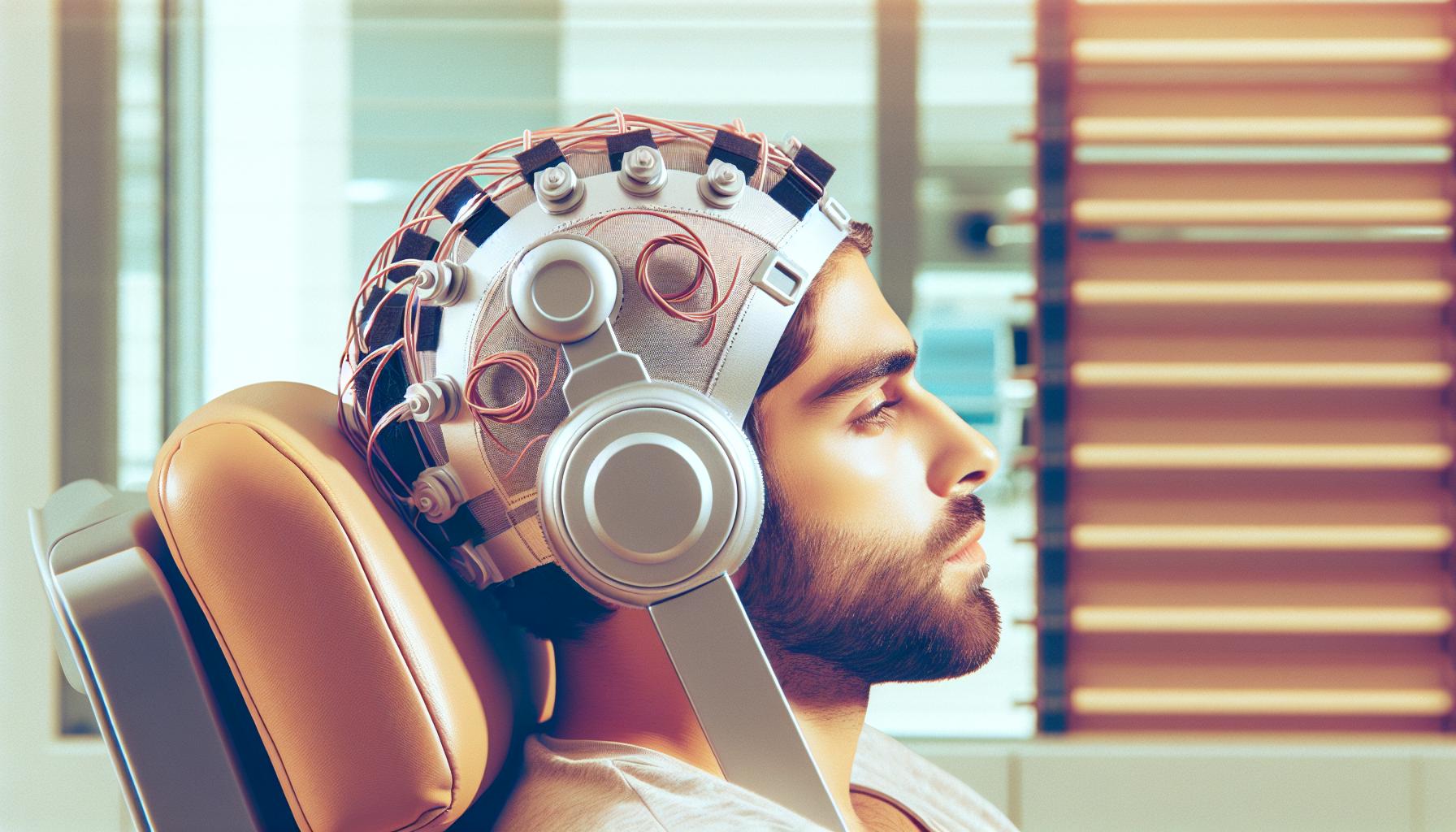Transcranial magnetic stimulation (TMS) is emerging as a groundbreaking treatment for various mental health conditions, sparking interest among both patients and healthcare professionals. This non-invasive procedure uses magnetic fields to stimulate nerve cells in the brain, offering hope for those who haven’t found relief through traditional therapies. Understanding its effectiveness is crucial for anyone considering TMS as a viable option for managing their mental health challenges.
Overview of Transcranial Magnetic Stimulation
Transcranial magnetic stimulation (TMS) employs magnetic fields to stimulate nerve cells in the brain. This non-invasive procedure targets specific brain regions associated with mood regulation and cognitive function. TMS involves placing an electromagnetic coil on the scalp, delivering short magnetic pulses to induce electrical currents in the underlying brain tissue.
Research indicates that TMS is particularly effective for treating major depressive disorder, especially in patients who have not responded well to traditional treatments. Clinical studies reveal that about 50% to 60% of individuals receiving TMS experience significant improvement in their symptoms. The treatment typically lasts around 20 to 40 minutes per session, with standard protocols recommending five sessions per week for four to six weeks.
Patients may experience mild side effects, including headache or discomfort at the site of stimulation. These effects are usually temporary and resolve shortly after treatment. However, long-term side effects are still being studied. Neuralia TMS is a leader in this field, providing insights into the TMS long term side effects and ensuring that patients are well-informed about both the benefits and risks of this therapy.
TMS is gaining recognition as a promising alternative therapy, and ongoing research continues to explore its efficacy for other mental health disorders, like anxiety and post-traumatic stress disorder (PTSD). Various medical professionals advocate its use as a vital component of comprehensive treatment plans tailored to the individual needs of patients.
Mechanism of Action

Transcranial magnetic stimulation (TMS) operates by delivering magnetic pulses to specific areas of the brain, influencing neuronal activity and contributing to treatment outcomes for various mental health conditions.
How TMS Works
TMS uses an electromagnetic coil that generates magnetic fields. This coil is placed on the scalp in targeted brain regions responsible for mood and cognitive functions. The magnetic pulses penetrate the skull and induce electrical currents in the neurons, leading to neuronal depolarisation. This process can enhance the excitability of these neurons, promoting more effective communication within neural circuits. Research shows that TMS can modulate neurotransmitter levels, especially serotonin, dopamine, and norepinephrine, which play crucial roles in mood regulation. Treatment typically consists of multiple sessions, with each lasting between 20 to 40 minutes, optimising the cumulative effects of stimulation over time.
Neurophysiological Effects
TMS influences the brain’s neurophysiology in several ways. Studies reveal that TMS promotes synaptic plasticity, the brain’s ability to change and adapt in response to experiences. Enhanced synaptic plasticity correlates with improved mood and cognitive functions. Additionally, TMS can alter resting state connectivity and induce changes in cortical excitability, reflecting increased engagement of areas involved in emotional regulation. By fine-tuning these brain circuits, TMS helps alleviate symptoms, particularly in major depressive disorder, where approximately 50% to 60% of individuals report significant improvements. Ongoing research continues to explore these neurophysiological effects, broadening the potential applications of TMS for treating various mental health disorders.
Clinical Applications
Transcranial magnetic stimulation (TMS) shows promise across several clinical applications, particularly in mental and physical health treatment options.
Treatment of Depression
TMS effectively treats major depressive disorder (MDD), providing significant relief for patients resistant to traditional therapies. Clinical studies demonstrate that 50% to 60% of MDD patients experience noticeable improvement following TMS treatment. The procedure stimulates specific brain areas involved in mood regulation, enhancing neuronal activity and improving mood regulation over a structured treatment plan of multiple sessions.
Management of Chronic Pain
TMS also plays a role in chronic pain management. Research indicates that TMS can reduce discomfort in conditions like fibromyalgia and chronic migraines. By inducing electrical activity in brain regions responsible for pain perception, TMS can help modulate pain signals and alleviate symptoms. Patients often report reduced reliance on medication and improved quality of life after consistent treatment.
Other Neurological Conditions
TMS is under investigation for its effects on various neurological conditions, including anxiety disorders, obsessive-compulsive disorder (OCD), and post-traumatic stress disorder (PTSD). Preliminary results suggest that TMS may help in symptom reduction for these disorders, potentially offering an alternative for patients seeking non-invasive options. Ongoing clinical trials aim to establish its efficacy and safety across broader neurological applications.
Evidence of Effectiveness
Transcranial magnetic stimulation (TMS) has garnered attention for its efficacy in treating various mental health conditions. Studies and clinical trials clearly demonstrate its positive impact, particularly in major depressive disorder (MDD).
Clinical Trials and Studies
Numerous clinical trials validate TMS’s effectiveness. A meta-analysis conducted by the American Psychiatric Association reported that approximately 50% to 60% of individuals with MDD achieve significant symptom reduction after undergoing TMS. Specific studies show that TMS not only alleviates depressive symptoms but also sustains improvements over time. For instance, a randomized controlled trial published in the Journal of Clinical Psychiatry found that patients maintained their response even six months post-treatment. Additional research indicates that TMS treatment may lead to a faster onset of relief compared to traditional medications, allowing patients to experience improved well-being sooner.
Patient Outcomes
Patient outcomes following TMS treatment reveal promising results. Surveys indicate that 30% to 40% of patients experience complete remission from depressive symptoms after TMS therapy. Many individuals report enhanced quality of life, improved functioning, and reduced reliance on antidepressant medications. Furthermore, a 2023 study in Neuropsychobiology identified that TMS significantly improved cognitive functions, including attention and memory, among patients. Long-term follow-up studies reinforce these findings, signalling that TMS can provide a sustainable option for managing depression and related disorders. Patients often express satisfaction with their treatment journey, highlighting TMS’s role in restoring emotional balance and functionality.
Potential Side Effects and Limitations
Transcranial magnetic stimulation (TMS) presents potential side effects and limitations that patients should consider. Awareness of these factors promotes informed decision-making regarding treatment.
Common Side Effects
Common side effects of TMS include headaches, scalp discomfort, and light-headedness. Headaches occur in approximately 30% of patients but typically resolve after the first few sessions. Scalp discomfort at the stimulation site may happen during or immediately after treatment but often subsides quickly. Light-headedness affects some patients, particularly when changing positions rapidly. Less common side effects can include tingling sensations, neck pain, and fatigue. Serious adverse effects, such as seizures, are rare, occurring in less than 1 in 30,000 treatments.
Limitations of TMS
TMS has limitations that may affect its suitability for certain individuals. Patients with implanted medical devices, such as pacemakers or cochlear implants, may face risks due to the electromagnetic fields generated during treatment. Individuals with a history of seizures or neurological disorders should consult healthcare professionals to determine if TMS is appropriate. TMS may not be effective for every patient, as approximately 30% to 50% of individuals do not experience significant symptom relief. Additionally, the need for multiple treatment sessions may pose logistical challenges for some patients. Continued research aims to refine TMS and expand its applications, but current limitations warrant careful consideration.
Future Directions
Transcranial Magnetic Stimulation (TMS) continues to evolve, with researchers exploring its potential beyond major depressive disorder (MDD). TMS’s adaptability opens doors for treating other mental health conditions and neurological disorders. Current studies focus on optimising treatment protocols, including adjusting stimulus frequency and intensity to enhance efficacy.
TMS is being investigated for various ailments, such as bipolar disorder, anxiety disorders, obsessive-compulsive disorder (OCD), and post-traumatic stress disorder (PTSD). Preliminary findings show promising outcomes, indicating that TMS may significantly alleviate symptoms. Additional trials seek to establish the long-term effects of TMS on these conditions.
Research also examines combining TMS with pharmacological treatments and other therapies. Combining modalities may enhance patient outcomes, particularly for those who do not respond to monotherapy. Clinical trials are underway to assess the efficacy of such combinations.
Understanding the neurophysiological mechanisms underlying TMS remains critical. Research aims to elucidate how TMS induces changes in brain activity and connectivity. Insights gained may improve treatment individualisation, targeting specific neural circuits associated with patients’ symptoms.
Furthermore, innovations in TMS technology are emerging. Developers are creating more portable devices, making treatment accessible in outpatient settings. Mobile TMS systems can facilitate at-home treatments, catering to patients with mobility issues or those who lack access to specialised centres.
Continued investigation into the safety and effectiveness of TMS enhances its acceptance as a mainstream treatment option. Ongoing research into potential side effects and patient profiles that best respond to TMS may help refine guidelines for its use.
As the body of evidence grows, TMS may establish itself as a key player in the future of mental health treatment, providing hope and effective care for individuals struggling with various conditions.
Conclusion
Transcranial magnetic stimulation represents a significant advancement in the treatment of mental health conditions. Its ability to target specific brain regions offers a new avenue for individuals struggling with major depressive disorder and other neurological issues. As research progresses the potential for TMS to enhance quality of life and reduce reliance on medications becomes clearer.
With promising outcomes reported in clinical trials and ongoing studies exploring its applications, TMS may soon become a cornerstone in comprehensive mental health treatment. Patients considering this innovative therapy can find reassurance in its growing body of evidence and the hope it brings for lasting symptom relief.
Frequently Asked Questions
What is transcranial magnetic stimulation (TMS)?
TMS is a non-invasive treatment that uses magnetic fields to stimulate nerve cells in the brain. It primarily targets areas associated with mood regulation to help treat conditions like major depressive disorder (MDD).
How effective is TMS for treating major depressive disorder (MDD)?
Research indicates that approximately 50% to 60% of patients with MDD experience significant symptom improvement after TMS treatment, with some achieving complete remission.
What can patients expect during a TMS session?
Each TMS session typically lasts between 20 to 40 minutes, with a recommended schedule of five sessions per week for four to six weeks. Patients can resume normal activities immediately after treatment.
Are there any side effects of TMS?
Common side effects include mild headaches, scalp discomfort, and light-headedness. These are usually temporary and resolve after the initial sessions. Serious side effects are rare.
Is TMS suitable for everyone?
TMS may not be suitable for individuals with implanted medical devices or a history of seizures. Additionally, about 30% to 50% of patients may not find significant symptom relief.
What other conditions can TMS help with?
Besides MDD, TMS shows promise in treating chronic pain conditions like fibromyalgia and migraines, as well as other mental health issues, including anxiety disorders, OCD, and PTSD.
How does TMS work in the brain?
TMS promotes synaptic plasticity, enhancing neuron excitability and improving communication within neural circuits. It also influences neurotransmitter levels, such as serotonin and dopamine, which are key for mood regulation.
What does ongoing research say about TMS?
Research continues to explore TMS’s efficacy beyond MDD, aiming to optimise treatment protocols and investigate its potential combined with medication to improve patient outcomes.
